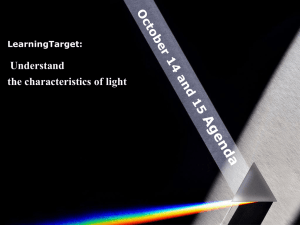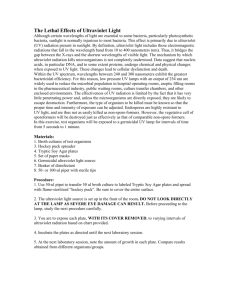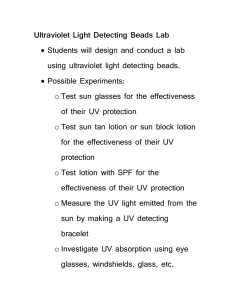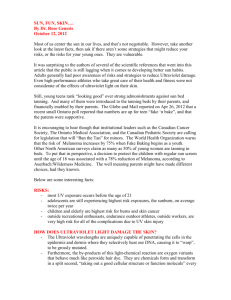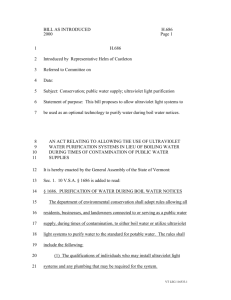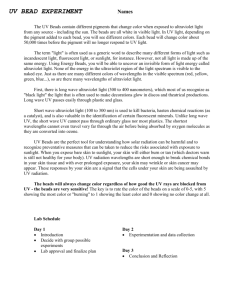Would you get a sunburn on Mars? CMMAP
advertisement
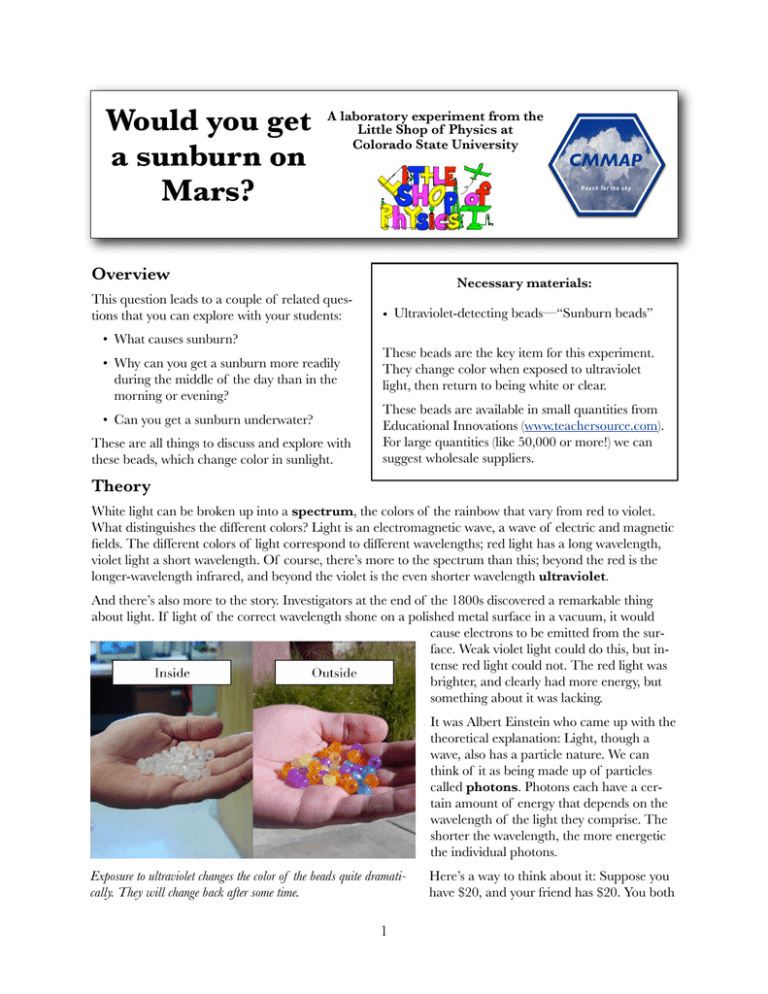
Would you get a sunburn on Mars? A laboratory experiment from the Little Shop of Physics at Colorado State University Reach for the sky. Overview This question leads to a couple of related questions that you can explore with your students: • What causes sunburn? • Why can you get a sunburn more readily during the middle of the day than in the morning or evening? • Can you get a sunburn underwater? These are all things to discuss and explore with these beads, which change color in sunlight. CMMAP Necessary materials: • Ultraviolet-detecting beads—“Sunburn beads” These beads are the key item for this experiment. They change color when exposed to ultraviolet light, then return to being white or clear. These beads are available in small quantities from Educational Innovations (www.teachersource.com). For large quantities (like 50,000 or more!) we can suggest wholesale suppliers. Theory White light can be broken up into a spectrum, the colors of the rainbow that vary from red to violet. What distinguishes the different colors? Light is an electromagnetic wave, a wave of electric and magnetic fields. The different colors of light correspond to different wavelengths; red light has a long wavelength, violet light a short wavelength. Of course, there’s more to the spectrum than this; beyond the red is the longer-wavelength infrared, and beyond the violet is the even shorter wavelength ultraviolet. And there’s also more to the story. Investigators at the end of the 1800s discovered a remarkable thing about light. If light of the correct wavelength shone on a polished metal surface in a vacuum, it would cause electrons to be emitted from the surface. Weak violet light could do this, but intense red light could not. The red light was brighter, and clearly had more energy, but something about it was lacking. It was Albert Einstein who came up with the theoretical explanation: Light, though a wave, also has a particle nature. We can think of it as being made up of particles called photons. Photons each have a certain amount of energy that depends on the wavelength of the light they comprise. The shorter the wavelength, the more energetic the individual photons. Exposure to ultraviolet changes the color of the beads quite dramatically. They will change back after some time. 1 Here’s a way to think about it: Suppose you have $20, and your friend has $20. You both have the same amount of money. But suppose your $20 is in quarters, and your friend's money is in dimes. Your have the same amount of money, but yours comes in larger “chunks.” Hungry for a snack, you find a vending machine, but it won’t take any coin smaller than a quarter. You can put in coins and make transactions, but your friend is out of luck. She’s got $20, but no coin large enough to work the machine. It's like that with red and ultraviolet light. In energy terms, if red light is a dime, ultraviolet is a quarter—it's got about 2½ times as much energy. Red light is made of photons that don't have enough energy to break chemical bonds. But ultraviolet light is made of photons with enough energy, and ultraviolet photons will do so. The irritation from this damage is what causes sunburn. That’s why the beads change color in the sun—photons of ultraviolet have enough energy to cause a (reversible) chemical change in the beads that makes them change color. More ultraviolet means a stronger reaction, and a darker color. The ultraviolet spectrum is broken into three bands, with UV-A having the longest wavelength (and lowest energy photons) and UV-C the shortest wavelength (and highest energy photons.) The photons of UV-C have enough energy to be very damaging to life; UV-C is used in sterilizers, as it will kill microorganisms. (It's also pretty tough on mammals, especially our eyes.) Fortunately, the ozone in the upper atmosphere absorbs virtually all of the incoming UV-C. UV-A and UV-B do make it through, but they are significantly attenuated by the atmosphere. If the sun is lower, the photons have to go through a much greater thickness of air—and chances are they won't. Most are absorbed. So you won't get a sunburn at sunrise, but you will get one at midday. Can you get a sunburn underwater? You can, up to a certain depth. Can you get a sunburn from the light through a window? Maybe. It depends on the type of glass. All window glass transmits visible light (that's the point!) but some don't transmit ultraviolet. These are all things that your students could test... Doing the Experiment This is a great inquiry experiment. Students can string beads and then use them to test for the presence of ultraviolet—higher intensity ultraviolet produces a darker bead color. You can ask them to suggest questions to test. Some things your students could explore, in addition to the bits noted above: • How does ultraviolet vary with time of day? With cloud cover? (Cloud cover blocks ultraviolet too.) • Can you get sunburned in the shade? (You can—ultraviolet is strongly scattered. Half the ultraviolet exposure you get comes directly from the sun, half from scattered ultraviolet that comes from all directions.) • Are there lights that emit ultraviolet? (Many do, especially “full spectrum” bulbs and “black” lights.) • How effective are different types of sunscreen? • Can fabrics transmit ultraviolet? (Indeed they can! Just because you are covered up, that doesn't mean you won't get a sunburn. Some fabrics are pretty good at blocking ultraviolet, but others aren't.) Summing Up So, would you get a sunburn on Mars? Indeed. If you were out long enough, you’d get a deadly one. The light from the sun is weaker at Mars’ greater distance, but Mars’ thin atmosphere doesn’t block as much ultraviolet, and it doesn’t completely block the damaging UV-C. A day in the sunlight on the surface of Mars would be no day at the beach! Our atmosphere may look clear, but it’s not. It stops the most damaging parts of light from the sun, allowing life to flourish on our blue-green ball. For More Information CMMAP, the Center for Multi-Scale Modeling of Atmospheric Processes: http://cmmap.colostate.edu Little Shop of Physics: http://littleshop.physics.colostate.edu 2
